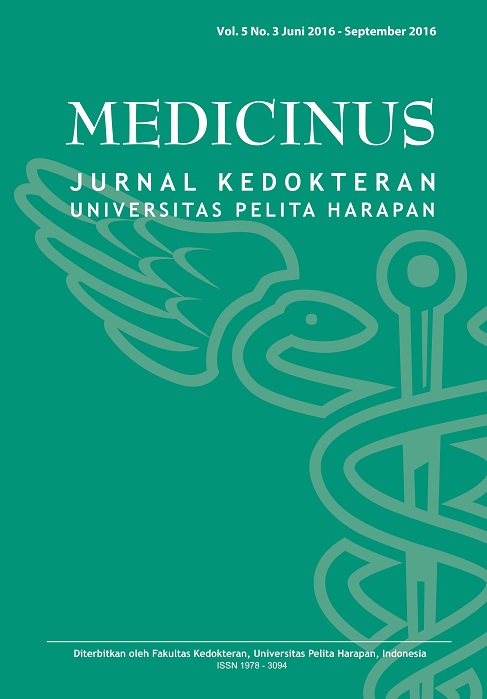Third-Degree Atrioventricular Block in Clinically “Silent” Acute Myocardial Infarction
DOI:
https://doi.org/10.19166/med.v5i3.1173Abstrak
Third-degree atrioventricular (AV) block also termed complete heart block is present when there is complete absence of conduction between atria and ventricles. In adults the most common causes are acute myocardial infarction and age-related degeneration of conduction system. Incidence of conduction block is reported to be 25-30 % in the setting of acute myocardial infarction (AMI) and is 2 to 3 times as commonly associated with inferior than anterior infarction. Proper diagnosis involves noninvasive diagnostic tests (12 lead electrocardiogram (ECG), Holter ECG, or stress/exercise ECG).
Keywords: third-degree AV block, complete av block, acute myocardial infarction
Referensi
Braunwald E, Mann DL. Braunwald's heart disease : a textbook of cardiovascular medicine. Philadelphia, Pa.: Elsevier Saunders; 2015.
Steg PG, James SK, Atar D, Badano LP, Lundqvist CB, Borger MA, et al. ESC Guidelines for the management of acute myocardial infarction in patients presenting with ST-segment elevation. The Task Force on the management of ST-segment elevation acute myocardial infarction of the European Society of Cardiology (ESC). 2012 2012-10-01 00:00:00;33(20):2569-619.
Bloch Thomsen PE, Jons C, Raatikainen MJ, Moerch Joergensen R, Hartikainen J, Virtanen V, et al. Long-term recording of cardiac arrhythmias with an implantable cardiac monitor in patients with reduced ejection fraction after acute myocardial infarction: the Cardiac Arrhythmias and Risk Stratification After Acute Myocardial Infarction (CARISMA) study. Circulation. 2010 Sep 28;122(13):1258-64. PubMed PMID: 20837897. Epub 2010/09/15. eng.
Brignole M, Auricchio A, Baron-Esquivias G, Bordachar P, Boriani G, Breithardt OA, et al. 2013 ESC guidelines on cardiac pacing and cardiac resynchronization therapy: the task force on cardiac pacing and resynchronization therapy of the European Society of Cardiology (ESC). Developed in collaboration with the European Heart Rhythm Association (EHRA). Europace : European pacing, arrhythmias, and cardiac electrophysiology : journal of the working groups on cardiac pacing, arrhythmias, and cardiac cellular electrophysiology of the European Society of Cardiology. 2013 Aug;15(8):1070-118. PubMed PMID: 23801827. Epub 2013/06/27. eng.
Brady WJ, Jr., Harrigan RA. Diagnosis and management of bradycardia and atrioventricular block associated with acute coronary ischemia. Emergency medicine clinics of North America. 2001 May;19(2):371-84, xi-xii. PubMed PMID: 11373984. Epub 2001/05/26. eng.
Vogler J, Breithardt G, Eckardt L. Bradyarrhythmias and conduction blocks. Revista espanola de cardiologia (English ed). 2012 Jul;65(7):656-67. PubMed PMID: 22627074. Epub 2012/05/26. eng
Klabunde RE, Klabunde RE. Cardiovascular physiology concepts. Philadelphia: Wolters Kluwer Health/Lippincott Williams & Wilkins; 2012.
JAMES TN. Anatomy of the Coronary Arteries in Health and Disease. Circulation. 1965;32(6):1020-33.
Richard W, James F, Valentin F, Robert OR. Hurst's the Heart Manual of Cardiology, Thirteenth Edition: McGraw-Hill Professional; 2012. -1 p.
Anderson KR, Murphy JG. The atrio-ventricular node artery in the human heart. Angiology. 1983 Nov;34(11):711-6. PubMed PMID: 6638606. Epub 1983/11/01. eng.
Priori SG, Blomström-Lundqvist C, Mazzanti A, Blom N, Borggrefe M, Camm J, et al. 2015 ESC Guidelines for the management of patients with ventricular arrhythmias and the prevention of sudden cardiac death. The Task Force for the Management of Patients with Ventricular Arrhythmias and the Prevention of Sudden Cardiac Death of the European Society of Cardiology (ESC)Endorsed by: Association for European Paediatric and Congenital Cardiology (AEPC). 2015 2015-08-29 00:00:00.
Cardoso R, Alfonso CE, Coffey JO. Reversibility of High-Grade Atrioventricular Block with Revascularization in Coronary Artery Disease without Infarction: A Literature Review. Case reports in cardiology. 2016;2016:1971803. PubMed PMID: 26925272. Pubmed Central PMCID: PMC4746340. Epub 2016/03/01. eng.
Epstein AE, DiMarco JP, Ellenbogen KA, Mark Estes INA, Freedman RA, Gettes LS, et al. ACC/AHA/HRS 2008 Guidelines for Device-Based Therapy of Cardiac Rhythm Abnormalities: Executive SummaryA Report of the American College of Cardiology/American Heart Association Task Force on Practice Guidelines (Writing Committee to Revise the ACC/AHA/NASPE 2002 Guideline Update for Implantation of Cardiac Pacemakers and Antiarrhythmia Devices) Developed in Collaboration With the American Association for Thoracic Surgery and Society of Thoracic Surgeons. Journal of the American College of Cardiology. 2008;51(21):2085-105.
Tabibiazar R, Edelman SV. Silent Ischemia in People With Diabetes: A Condition That Must Be Heard. Clinical Diabetes. 2003;21(1):5-9.
Chiariello M, Indolfi C. Silent Myocardial Ischemia in Patients With Diabetes Mellitus. Circulation. 1996;93(12):2089-91.
Unduhan
Diterbitkan
Cara Mengutip
Terbitan
Bagian
Lisensi
Hak Cipta (c) 2018 Vito Damay

Artikel ini berlisensiCreative Commons Attribution-ShareAlike 4.0 International License.
Authors who publish with this journal agree to the following terms:
1) Authors retain copyright and grant the journal right of first publication with the work simultaneously licensed under a Creative Commons Attribution License (CC-BY-SA 4.0) that allows others to share the work with an acknowledgement of the work's authorship and initial publication in this journal.
2) Authors are able to enter into separate, additional contractual arrangements for the non-exclusive distribution of the journal's published version of the work (e.g., post it to an institutional repository or publish it in a book), with an acknowledgement of its initial publication in this journal.
3) Authors are permitted and encouraged to post their work online (e.g., in institutional repositories or on their website). The final published PDF should be used and bibliographic details that credit the publication in this journal should be included.





